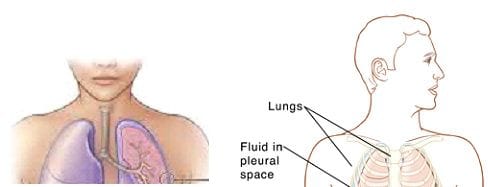chest
Chest
Percutaneous chest tube

A chest tube is a hollow plastic or silicone tube with the tip positioned within the pleural space of your lungs. The pleural space is the space between the inner and outer lining of your lungs where fluid and/or gas can accumulate.



The main purpose of a chest tube is to drain fluid and/or air from your pleural space. Fluid and air may collect in the pleural space for many different reasons including post surgical, traumatic, infectious, and malignant reasons. How long you need your drain, the amount of drainage and the color of drainage will be different for every patient. Discuss with your doctor to determine the how long he or she anticipates your drain will stay in for.
- Change dressing every 7 days or whenever dressing is wet, dirty, or loose
- If your tube drains into a container, empty the container or drainage bag before it gets full. Record output and color of fluid in MDC tracker.
Supplies needed
- Medical tape
- Two 4” x 4” drain split pads
- Two dressing standard gauze pads
Steps to dressing changes:

- Wash and dry your hands
- Remove old chest tube dressing. Be mindful not to pull on the chest tube. Throw mt-25 old dressing away.
- Clean area around chest tube insertion site with soap and warm water. Let area dry.
- Take two drain split pads and place around chest tube (as pictured). If you do not have the precut drain pads, you can cut the slits on standard gauze pads as seen below.
- Open two more standard drain pads and place these two gauze pads over the split pads.
- Put medical tape covering the gauze pads and tube


Your chest tube drainage end will likely be connected to a heimlich valve which is connected to a small plastic container or drainage bag. The type of collection device you have depends on the volume of fluid you are draining. How often you need to empty your collection device will depend on how much fluid is draining from your chest. Your doctor will inform you how often to expect to empty your collection device/bag.
Follow these steps to empty drainage bag:
- Check how much fluid is in your collection device. Record amount and color in your MDC tracker.
- Open collection device and empty fluid into toilet.
- Close collection device.
- Wash and dry hands.
Showering guidelines

You may take a shower with your chest tube but it is important to keep your chest tube dressing dry. You can place a waterproof dressing cover such as AquaGuard over the dressing to help it dry. Using a handheld showerhead can also be helpful. If your dressing is damp or wet after a shower, it is important to change the dressing. Wet and damp dressing can irritate your skin and lead to problems such as skin infection.
Do not submerge your dressing and chest tube in water. This includes taking a bath, using a hot tub, or swimming.
- Fever of 101 °F (38.3 °C) or higher.
- Skin around insertion site is red, swelling, warm, or painful to touch
- Drainage leaking around the insertion site of the tube
- Pain at site or around chest tube insertion site not improving with pain medications
- Increasing drainage than usual from chest tube
- Changes and thickness of fluid draining
- Tube is coming out, bent, or broken
